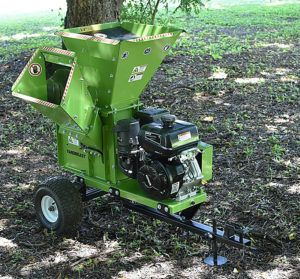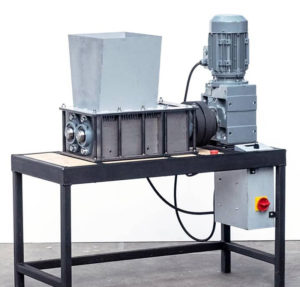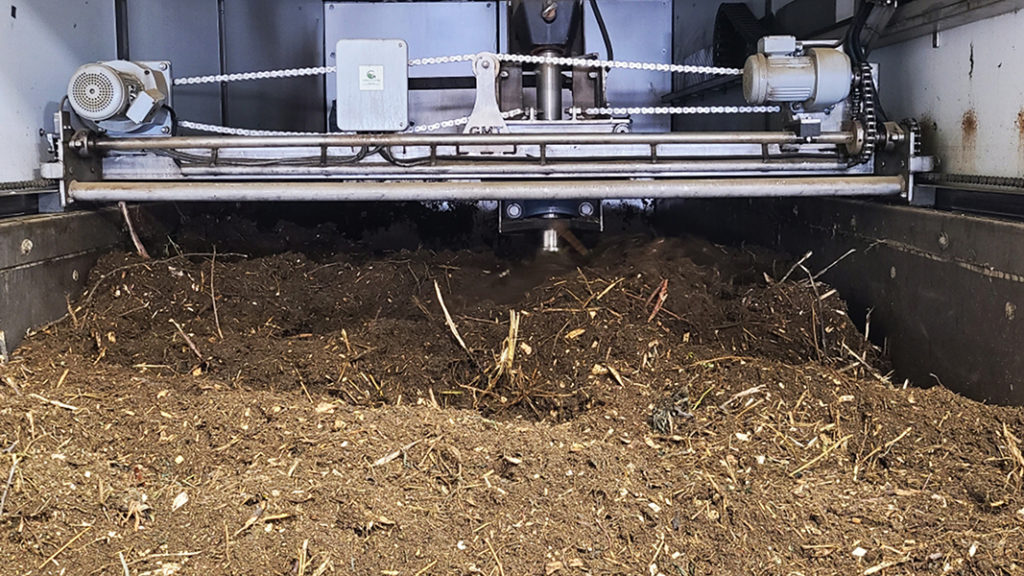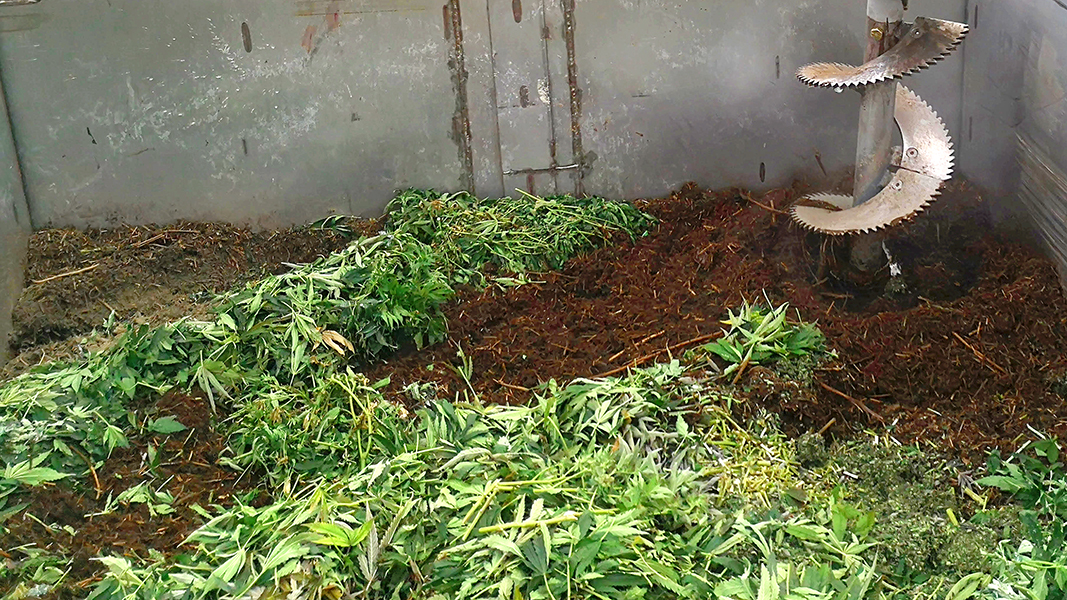Top: Cannabis fan leaves being composted. Photo courtesy of Green Mountain Technologies (GMT)
Van Calvez
Since the grinding of all cannabis waste is a requirement for many state regulations, aspiring composters of cannabis will need to contend with these rules. This is a particular challenge for generators who produce a small amount of cannabis waste on a daily basis.
From the standpoint of aerobic composting, the grinding of fan leaves is probably optional and possibly even detrimental in the compost pile (because of densification). The small size of cannabis leaves doesn’t necessitate grinding. However, because of the regulations, it often has to be done.
Grinding stems is a different story. From a biological standpoint, if the stems are to be included in the compost mix, grinding them is critical for effective composting. These fibrous stems will not compost rapidly and will actually slow the composting process because they introduce excessive air space in the compost matrix. To make these feedstocks useful for aerobic composting, the stems must be shredded to a fiber length of less than 6 inches (ideally 1 inch or less).
Grinding Technologies

Typical chipper/shredder Source: Makinnen CC BY-SA 4.0
The available tools for grinding cannabis waste are somewhat limited, particularly at a small scale. Two of the most commonly available tools for grinding cannabis waste include chipper/shredders and slow-speed grinders.
- Chipper/shredders: A standard chipper/shredder may be either gasoline or electric powered. These hammermill-type units have high-speed flails and tend to throw chopped materials and generate loud sounds while grinding. The shredders are also not ideal for shredding wet waste. Wet feedstocks tend to clog a standard chipper/shredder. Overall, a chipper/shredder is not a perfect solution for grinding cannabis residuals. However, for generators of small amounts of cannabis waste, it may be one of the few affordable grinders available.

Slow-speed grinder Source: Precious Plastics, CC BY-SA 4.0
- Slow-speed grinders: A type of technology that is more ideal in terms of handling cannabis waste is a slow-speed grinder (also known as a twin-shaft grinder). These excel at grinding wet feedstocks, such as fan leaves and material that is difficult to shred, such as fibrous stems. The particle size will be smaller so material will compost more quickly — and create a compost with a more attractive and uniform appearance. The downside is that slow-speed grinders are relatively expensive, compared to chipper/shredders of comparable size.
Effective Cannabis Composting Recipes
To build an effective composting recipe for cannabis feedstocks, we first need to know which types of cannabis waste are being composted. In particular, composting cannabis waste from a grow operation is significantly different than composting residuals from a processor. For this article, we built sample cannabis recipes of these feedstocks using Green Mountain Technologies’ Compost Calc software.
Many assumptions are being made in these examples about feedstock characteristics, including starting moisture content, particle size, etc. Change the assumptions and the results will be different. Compost Calc estimated the carbon-nitrogen ratio (C:N) for this mixture to be 25:1. Further, it predicted a starting moisture content of 62% and a bulk density of 500 lbs/cubic yard (cy). These results indicate that the cannabis residuals form a reasonably balanced recipe all by themselves, with a desirable C:N ratio, a good moisture balance and adequate porosity.
Here are a couple examples of effective cannabis composting recipes.
Example #1. Grow Residuals
Let’s say we need to build a compost recipe around residuals from a cannabis grow operation, primarily a mix of leaf and stem with a small amount of growing media added in. We also assume that the regulatory requirement will be met for the cannabis to be mixed at least 50%-50% by volume with non-cannabis waste to render the cannabis waste unusable, as discussed in Part I.
To start, let’s assume we have the following cannabis feedstocks by volume: 3 parts shredded fan leaf and 1 part shredded stem. To meet the 50%-50% rule for non-cannabis waste, something like 2 parts wood chips and 2 parts grass clippings need to be added. This also happens to be a fairly balanced composting recipe.
Combining all these feedstocks into one recipe yields 5 parts “greens” (shredded cannabis leaves and grass clippings) to 3 parts “browns” (shredded stems or wood chips). Compost Calc predicts a resulting recipe with a C:N ratio of 30:1 and a moisture content of 63%. Bulk density remains the same at 500 lbs/cy. In this case, the non-cannabis waste does not appreciably change the characteristics of the recipe. In addition, Small amounts of grow media added to this recipe would not appreciably change the key composting parameters.
Example #2. Processed Flower/Bud Residuals
This next example starts with cannabis processing residuals. These flower/bud/leaf process residuals typically have a consistency of sawdust or crumbly cereal with high nitrogen, but low moisture content and low porosity. To build an effective compost recipe, we will need to balance these feedstocks by increasing moisture content, carbon and porosity.
Adding moisture to this very dry feedstock can be tricky in the same way it can be difficult to add water to very dry soil. The dry feedstock can be hydrophobic and actually resist the addition of water. One strategy is to combine this finely ground flower/bud waste with a feedstock that already has a high integral moisture content, such as shredded green waste or food scraps. Another trick would be to soak wood chips in water prior to blending with the cannabis waste in order to add the moisture integral to the bulking agent rather than adding the water separately.

Processed flower/bud residuals being composted in a GMT Earth Flow vessel at ENSO in Oklahoma. Photo courtesy of GMT
Here is an example of an effective compost recipe by volume for this flower/bud residual: 1 to 2 parts shredded green waste and/or wet (soaked) wood chips and 1 part flower/bud crumble/dust. The green waste (or wet wood chip) provides the porosity and moisture content needed to balance the fine texture and lower moisture content of the flower/bud residual. This also satisfies the 50%-50% requirement for non-cannabis waste while providing an effective hot composting recipe.
Building an effective composting recipe for cannabis feedstocks starts with closely examining the nature of the cannabis feedstocks available for composting. Next is to provide complementary feedstocks to meet regulatory requirements and balance moisture, porosity and C:N ratio. Once in the windrow, aerated static pile or vessel, these cannabis-based recipes should be composted according to best composting management practices to achieve satisfactory results.
Van Calvez, a Composting Systems Designer and Engineer with Green Mountain Technologies (GMT), specializes in in-vessel composting systems for organizations and communities.














